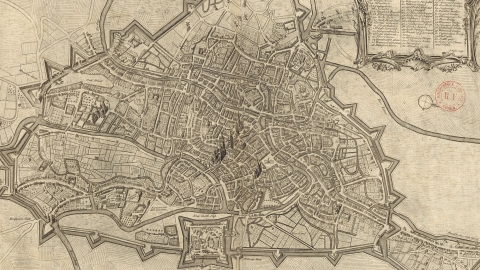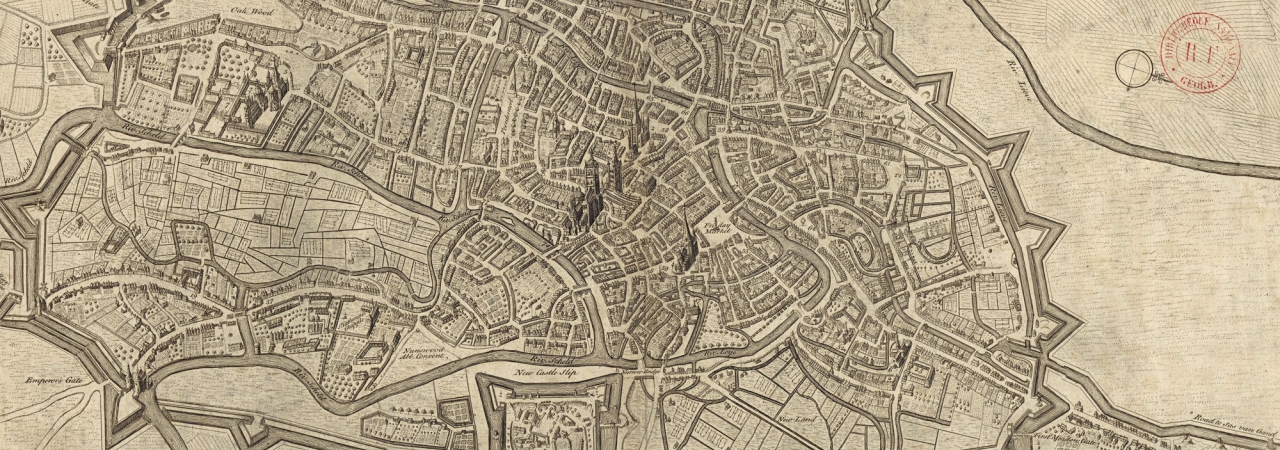In the course of the religious troubles in the 16th century, Ghent only had its non-modified medieval fortifications. The only "modern" fortification was the so-called Spaniard Castle that Emperor Charles had built as a sort of citadel in 1540 to keep the population of Ghent under control. This fort was thus the first use of bastions in the Netherlands. It was a square fort in natural stone erected on the site of the demolished abbey, Sint-Baafsabdij. Today, in the stone wall of the Napoleon de Pauwvertakking where this enters the Visserijvaart, a bastion can still be seen in the natural stone which contrasts with the brickwork.
In the course of the religious troubles in the 16th century, Ghent only had its non-modified medieval fortifications. The only "modern" fortification was the so-called Spaniard Castle that Emperor Charles had built as a sort of citadel in 1540 to keep the population of Ghent under control. This fort was thus the first use of bastions in the Netherlands. It was a square fort in natural stone erected on the site of the demolished abbey, Sint-Baafsabdij. Today, in the stone wall of the Napoleon de Pauwvertakking where this enters the Visserijvaart, a bastion can still be seen in the natural stone which contrasts with the brickwork.
With the proclamation of the Calvinist Republic (1577-1584), Ghent hastily started to build fortifications and existing fortifications were adapted, often by incorporating them in earthen embankments, digging new canals and building earthen bastions and ravelins. Although nearly all the traces have disappeared, you can still see a strange second channel between Ledeberg and Gent Keizerpoort. If you look on the map, you can recognise the triangular shapes of the ravelins.
The odd natural stone tower, also called "Peperbus", that juts out over the Scheldt on the Isabellakaai is another remnant of the new fortification. It was a watchtower at the end of the wall/fortification between Heuvelpoort up to the Kortrijksepoort that looked out over the Scheldt.
On the site of the current Citadelpark, the Montereyfort was built in the period 1671-1694. At the start of the 19th century, this in turn made way for the citadel, which finally disappeared in 1907 to be replaced by a park.
The entire so-called small ring was actually constructed on the fortifications from that period, which explains why there is so little left. The triangular shape which has characterised Ghent for centuries thus dates from that time.
With the proclamation of the Calvinist Republic (1577-1584), Ghent hastily started to build fortifications and existing fortifications were adapted, often by incorporating them in earthen embankments, digging new canals and building earthen bastions and ravelins. Although nearly all the traces have disappeared, you can still see a strange second channel between Ledeberg and Gent Keizerpoort. If you look on the map, you can recognise the triangular shapes of the ravelins.
The odd natural stone tower, also called "Peperbus", that juts out over the Scheldt on the Isabellakaai is another remnant of the new fortification. It was a watchtower at the end of the wall/fortification between Heuvelpoort up to the Kortrijksepoort that looked out over the Scheldt.
On the site of the current Citadelpark, the Montereyfort was built in the period 1671-1694. At the start of the 19th century, this in turn made way for the citadel, which finally disappeared in 1907 to be replaced by a park.
The entire so-called small ring was actually constructed on the fortifications from that period, which explains why there is so little left. The triangular shape which has characterised Ghent for centuries thus dates from that time.



